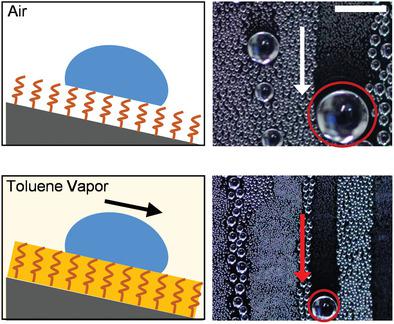当前位置:
X-MOL 学术
›
Adv. Mater.
›
论文详情
Our official English website, www.x-mol.net, welcomes your
feedback! (Note: you will need to create a separate account there.)
Vapor Lubrication for Reducing Water and Ice Adhesion on Poly(dimethylsiloxane) Brushes
Advanced Materials ( IF 27.4 ) Pub Date : 2022-06-30 , DOI: 10.1002/adma.202203242 Shuai Li 1 , Youmin Hou 1, 2 , Michael Kappl 1 , Werner Steffen 1 , Jie Liu 1, 3 , Hans-Jürgen Butt 1
Advanced Materials ( IF 27.4 ) Pub Date : 2022-06-30 , DOI: 10.1002/adma.202203242 Shuai Li 1 , Youmin Hou 1, 2 , Michael Kappl 1 , Werner Steffen 1 , Jie Liu 1, 3 , Hans-Jürgen Butt 1
Affiliation

|
Fast removal of small water drops from surfaces is a challenging issue in heat transfer, water collection, or anti-icing. Poly(dimethylsiloxane) (PDMS) brushes show good prospects to reach this goal because of their low adhesion to liquids. To further reduce adhesion of water drops, here, the surface to the vapor of organic solvents such as toluene or n-hexane is exposed. In the presence of such vapors, water drops slide at lower tilt angle and move faster. This is mainly caused by the physisorption of vapor and swelling of the PDMS brushes, which serves as a lubricating layer. Enhanced by the toluene vapor lubrication, the limit departure volume of water drop on PDMS brushes decreases by one order of magnitude compared to that in air. As a result, the water harvesting efficiency in toluene vapor increases by 65%. Benefits of vapor lubrication are further demonstrated for de-icing: driven by gravity, frozen water drops slide down the vertical PDMS brush surface in the presence of vapor.
中文翻译:

减少聚(二甲基硅氧烷)刷上的水和冰粘附的蒸汽润滑
从表面快速去除小水滴是传热、集水或防冰方面的一个具有挑战性的问题。聚(二甲基硅氧烷)(PDMS)刷子由于对液体的低附着力而显示出实现这一目标的良好前景。为了进一步减少水滴的粘附,此处暴露了甲苯或正己烷等有机溶剂蒸气的表面。在存在这种蒸汽的情况下,水滴以较低的倾斜角滑动并移动得更快。这主要是由蒸汽的物理吸附和作为润滑层的 PDMS 刷的膨胀引起的。通过甲苯蒸汽润滑,PDMS刷子上水滴的极限离开体积比空气中的减少了一个数量级。结果,甲苯蒸汽中的水收集效率提高了 65%。
更新日期:2022-06-30
中文翻译:

减少聚(二甲基硅氧烷)刷上的水和冰粘附的蒸汽润滑
从表面快速去除小水滴是传热、集水或防冰方面的一个具有挑战性的问题。聚(二甲基硅氧烷)(PDMS)刷子由于对液体的低附着力而显示出实现这一目标的良好前景。为了进一步减少水滴的粘附,此处暴露了甲苯或正己烷等有机溶剂蒸气的表面。在存在这种蒸汽的情况下,水滴以较低的倾斜角滑动并移动得更快。这主要是由蒸汽的物理吸附和作为润滑层的 PDMS 刷的膨胀引起的。通过甲苯蒸汽润滑,PDMS刷子上水滴的极限离开体积比空气中的减少了一个数量级。结果,甲苯蒸汽中的水收集效率提高了 65%。


















































 京公网安备 11010802027423号
京公网安备 11010802027423号